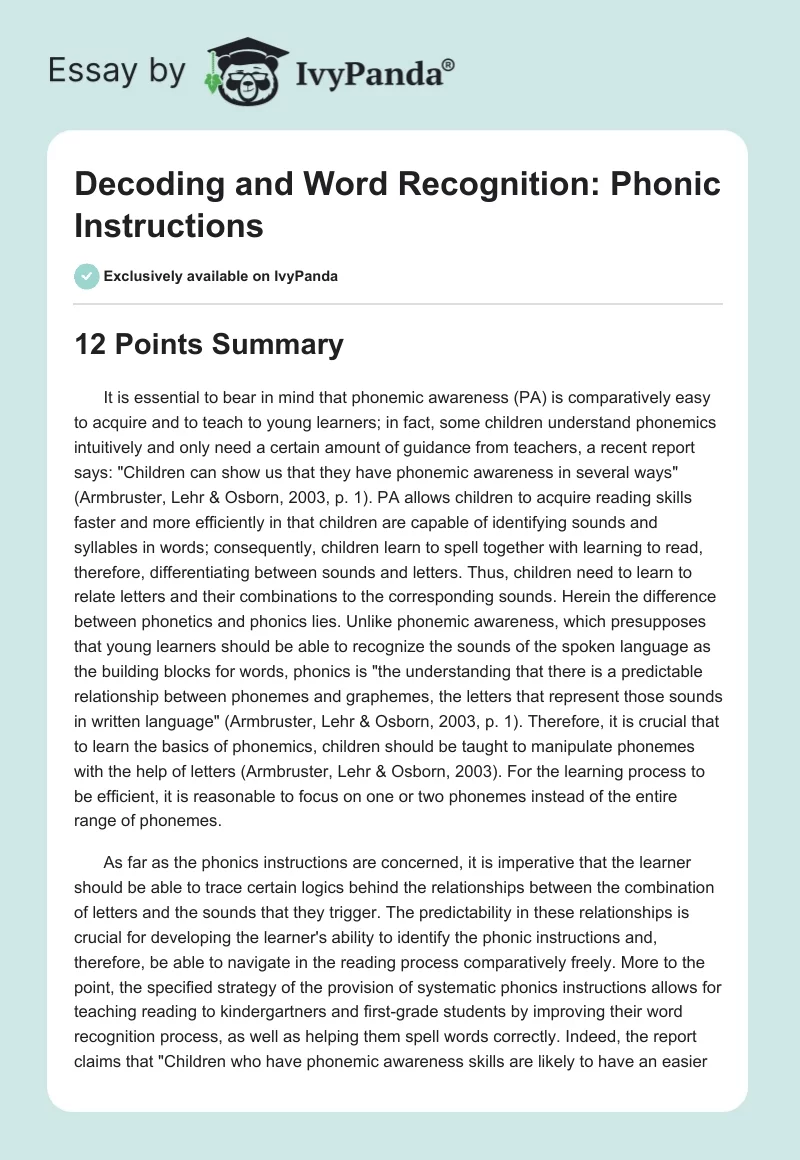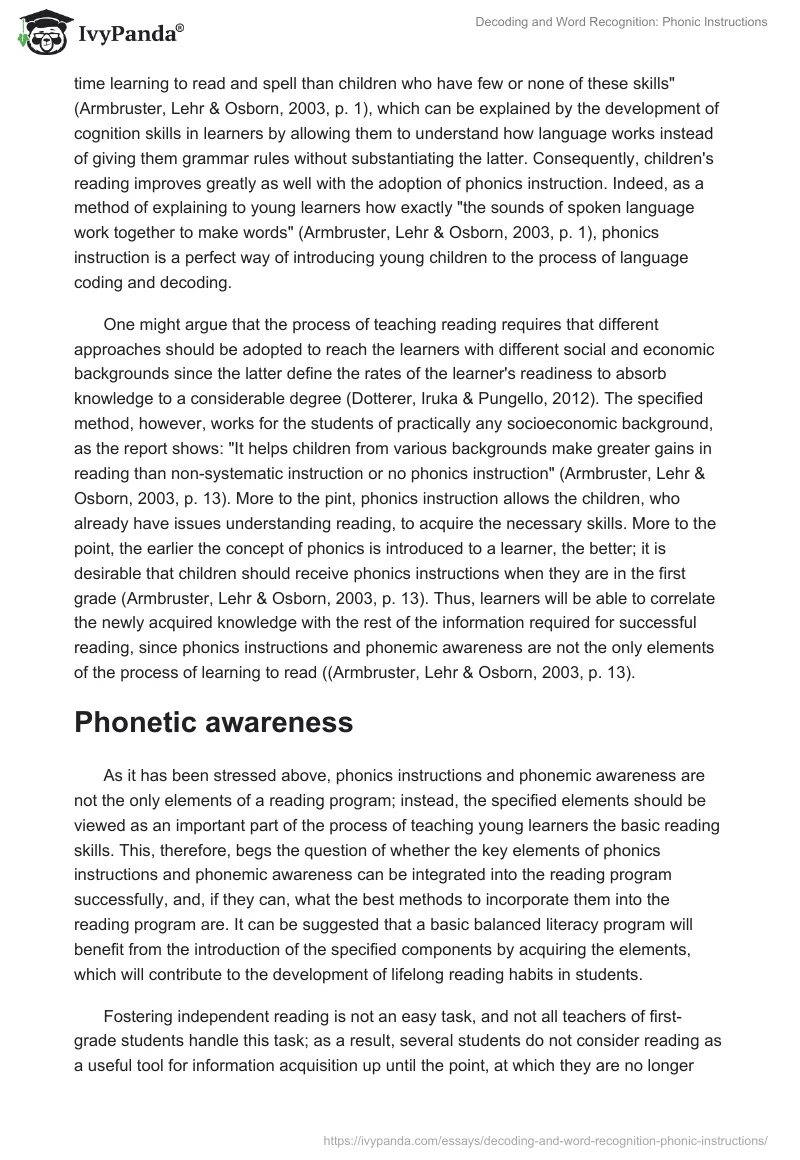12 Points Summary
It is essential to bear in mind that phonemic awareness (PA) is comparatively easy to acquire and to teach to young learners; in fact, some children understand phonemics intuitively and only need a certain amount of guidance from teachers, a recent report says: “Children can show us that they have phonemic awareness in several ways” (Armbruster, Lehr & Osborn, 2003, p. 1). PA allows children to acquire reading skills faster and more efficiently in that children are capable of identifying sounds and syllables in words; consequently, children learn to spell together with learning to read, therefore, differentiating between sounds and letters. Thus, children need to learn to relate letters and their combinations to the corresponding sounds. Herein the difference between phonetics and phonics lies. Unlike phonemic awareness, which presupposes that young learners should be able to recognize the sounds of the spoken language as the building blocks for words, phonics is “the understanding that there is a predictable relationship between phonemes and graphemes, the letters that represent those sounds in written language” (Armbruster, Lehr & Osborn, 2003, p. 1). Therefore, it is crucial that to learn the basics of phonemics, children should be taught to manipulate phonemes with the help of letters (Armbruster, Lehr & Osborn, 2003). For the learning process to be efficient, it is reasonable to focus on one or two phonemes instead of the entire range of phonemes.
As far as the phonics instructions are concerned, it is imperative that the learner should be able to trace certain logics behind the relationships between the combination of letters and the sounds that they trigger. The predictability in these relationships is crucial for developing the learner’s ability to identify the phonic instructions and, therefore, be able to navigate in the reading process comparatively freely. More to the point, the specified strategy of the provision of systematic phonics instructions allows for teaching reading to kindergartners and first-grade students by improving their word recognition process, as well as helping them spell words correctly. Indeed, the report claims that “Children who have phonemic awareness skills are likely to have an easier time learning to read and spell than children who have few or none of these skills” (Armbruster, Lehr & Osborn, 2003, p. 1), which can be explained by the development of cognition skills in learners by allowing them to understand how language works instead of giving them grammar rules without substantiating the latter. Consequently, children’s reading improves greatly as well with the adoption of phonics instruction. Indeed, as a method of explaining to young learners how exactly “the sounds of spoken language work together to make words” (Armbruster, Lehr & Osborn, 2003, p. 1), phonics instruction is a perfect way of introducing young children to the process of language coding and decoding.
One might argue that the process of teaching reading requires that different approaches should be adopted to reach the learners with different social and economic backgrounds since the latter define the rates of the learner’s readiness to absorb knowledge to a considerable degree (Dotterer, Iruka & Pungello, 2012). The specified method, however, works for the students of practically any socioeconomic background, as the report shows: “It helps children from various backgrounds make greater gains in reading than non-systematic instruction or no phonics instruction” (Armbruster, Lehr & Osborn, 2003, p. 13). More to the pint, phonics instruction allows the children, who already have issues understanding reading, to acquire the necessary skills. More to the point, the earlier the concept of phonics is introduced to a learner, the better; it is desirable that children should receive phonics instructions when they are in the first grade (Armbruster, Lehr & Osborn, 2003, p. 13). Thus, learners will be able to correlate the newly acquired knowledge with the rest of the information required for successful reading, since phonics instructions and phonemic awareness are not the only elements of the process of learning to read ((Armbruster, Lehr & Osborn, 2003, p. 13).
Phonetic awareness
As it has been stressed above, phonics instructions and phonemic awareness are not the only elements of a reading program; instead, the specified elements should be viewed as an important part of the process of teaching young learners the basic reading skills. This, therefore, begs the question of whether the key elements of phonics instructions and phonemic awareness can be integrated into the reading program successfully, and, if they can, what the best methods to incorporate them into the reading program are. It can be suggested that a basic balanced literacy program will benefit from the introduction of the specified components by acquiring the elements, which will contribute to the development of lifelong reading habits in students.
Fostering independent reading is not an easy task, and not all teachers of first-grade students handle this task; as a result, several students do not consider reading as a useful tool for information acquisition up until the point, at which they are no longer able to develop the corresponding skills fast and efficiently enough. However, a range of independent reading programs creates the premises for children to adopt the specified strategies and acquire the needed skills in a very expeditious manner. Also, the specified strategies allow for promoting not only independent reading, but also shared reading among the students. An essential component of the balanced reading program, shared reading can be boosted to a considerable extent with the help of phonics instructions and phonemic awareness.
The aforementioned elements can be incorporated into the balanced literacy program with the introduction of consonant and vowel worksheets (Smith, 2008), which include lists of simple words and easily recognizable pronunciation patterns. Thus, young learners will be able to decode the traditional combinations of letters into the sounds that they denote, as well as use these combinations to code the corresponding sounds in the process of writing.
To be more particular, it is necessary to include the exercises, which help students differentiate between similar sounds, into the curriculum. A teacher must help young learners navigate in the seemingly complicated realm of the consonants and vowels, which have comparatively little differences and can be confused easily. By incorporating the phonics instruction into the course, teachers will help students identify the potentially difficult areas and prevent the possible understanding issues from emerging. This may presuppose the creation of worksheets with exercises for matching pictures with the corresponding words, etc. As a result, students will have no problems with further identification of words’ meaning and, therefore, with the coding and decoding process.
The techniques, which allow for incorporating the key principles of phonics instructions and phonetics awareness into the curriculum, are quite numerous. The choice of a proper strategy depends on the specifics of the learners, as well as the goals of the course. However, no matter what strategy the teacher chooses, the elements above must be included in the curriculum so that learners’ independence in reading should be promoted.
Reference List
Armbruster, B. B., Lehr, F. & Osborn, J. (2003). Put reading first. Berkeley, CA: National Institute for Literacy.
Dotterer, A. M., Iruka, I. U. & Pungello, E. (2012). Parenting, race, and socioeconomic status: Links to school readiness. Family Relations, 61(4), 657–670.
Smith, W. P. (2008). Phonics worksheets. Phonetics. K-12 Reader. Web.


